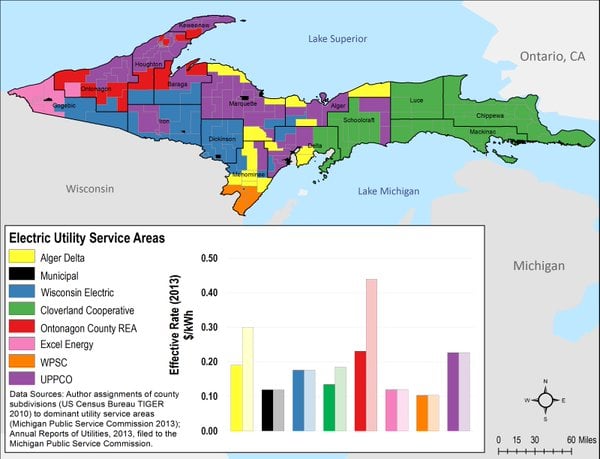J.M.Pearce (talk | contribs) (Created page with "{{MOST}} {{Pearce-pubs}} right|300px ==Source== * Abhilash Kantamneni, Richelle Winkler, Lucia Gauchia, Joshua M. Pearce, [http://dx.doi.org/10.1016/...") |
J.M.Pearce (talk | contribs) mNo edit summary |
||
| Line 1: | Line 1: | ||
{{MOST}} | {{MOST}} | ||
{{Pearce-pubs}} | {{Pearce-pubs}} | ||
[[image: | [[image:Grid-defect-biz.png|right|300px]] | ||
==Source== | ==Source== | ||
* | * Trevor B. Peffley & Joshua M.Pearce. The Potential for Grid Defection of Small and Medium Sized Enterprises Using Solar Photovoltaic, Battery and Generator Hybrid Systems. ''Renewable Energy''. | ||
** | https://doi.org/10.1016/j.renene.2019.12.039 [open access] | ||
==Highlights== | |||
* Northern US small & medium size enterprises (SMEs) self generation economics | |||
* Grid defection via hybrid solar photovoltaic, battery & generator technically viable | |||
* At current costs grid defection with solar hybrid system profitable | |||
* Utilities can encourage distributed generation to prevent utility death spiral | |||
* Grid defection is slightly sensitive to natural gas costs | |||
==Abstract== | ==Abstract== | ||
[[image:upmap.jpg|right]] | [[image:upmap.jpg|right]] Grid-tied solar photovoltaic (PV) systems enable lower cost electricity for small and medium size enterprises (SMEs) than they are currently paying for grid electricity in the U.S. These economic realities threaten conventional electric utilities, which have begun manipulating rate structures to reduce the profitability of distributed generation (DG), as well as putting arbitrary caps on DG in their service territories. SMEs may reduce electricity costs, if they can grid defect with hybrid captive power systems made up of solar, battery and generator subsystems. This paper analyzes the technical and economic viability for hybrid solar systems deployed in the commercial sector to enable self-generation. Specifically, for the first time, the economics of grid defection are analyzed for three case studies of SMEs in the northern U.S., which represent a challenging technical case because of long dark winters, but also have high utility costs. The results of the simulations make it clear that grid defection is already viable for SMEs with the current prices for all components in the solar hybrid system. These results were consistent across scale, load-profile, and utility rate. These economic projections included no government incentives or subsidies and can thus be considered extremely conservative for the specific case studies. Policy changes are discussed for electric utilities to avoid the potential of a utility death spiral in this and similar performing locations. | ||
==Keywords== | ==Keywords== | ||
[[Energy policy]]; Electric utility; [[Photovoltaic]]; [[Distributed generation]]; [[off-grid]]; [[Solar energy]] | [[Energy policy]]; Electric utility; [[Photovoltaic]]; [[Distributed generation]]; [[off-grid]]; [[Solar energy]]; hybrid system; battery; grid defection; autoproduction; captive power | ||
==See also== | ==See also== | ||
Revision as of 00:43, 10 December 2019

Source
- Trevor B. Peffley & Joshua M.Pearce. The Potential for Grid Defection of Small and Medium Sized Enterprises Using Solar Photovoltaic, Battery and Generator Hybrid Systems. Renewable Energy.
https://doi.org/10.1016/j.renene.2019.12.039 [open access]
Highlights
- Northern US small & medium size enterprises (SMEs) self generation economics
- Grid defection via hybrid solar photovoltaic, battery & generator technically viable
- At current costs grid defection with solar hybrid system profitable
- Utilities can encourage distributed generation to prevent utility death spiral
- Grid defection is slightly sensitive to natural gas costs
Abstract

Grid-tied solar photovoltaic (PV) systems enable lower cost electricity for small and medium size enterprises (SMEs) than they are currently paying for grid electricity in the U.S. These economic realities threaten conventional electric utilities, which have begun manipulating rate structures to reduce the profitability of distributed generation (DG), as well as putting arbitrary caps on DG in their service territories. SMEs may reduce electricity costs, if they can grid defect with hybrid captive power systems made up of solar, battery and generator subsystems. This paper analyzes the technical and economic viability for hybrid solar systems deployed in the commercial sector to enable self-generation. Specifically, for the first time, the economics of grid defection are analyzed for three case studies of SMEs in the northern U.S., which represent a challenging technical case because of long dark winters, but also have high utility costs. The results of the simulations make it clear that grid defection is already viable for SMEs with the current prices for all components in the solar hybrid system. These results were consistent across scale, load-profile, and utility rate. These economic projections included no government incentives or subsidies and can thus be considered extremely conservative for the specific case studies. Policy changes are discussed for electric utilities to avoid the potential of a utility death spiral in this and similar performing locations.
Keywords
Energy policy; Electric utility; Photovoltaic; Distributed generation; off-grid; Solar energy; hybrid system; battery; grid defection; autoproduction; captive power
See also
- Emerging economic viability of grid defection in a northern climate using solar hybrid systems
- Levelized cost of electricity for solar photovoltaic, battery and cogen hybrid systems
- Performance of U.S. hybrid distributed energy systems: Solar photovoltaic, battery and combined heat and power
- Review of solar levelized cost
- PV and CHP Hybrid System
- Hybrid photovoltaic-trigeneration systems
- Simulations of Greenhouse Gas Emission Reductions from Low-Cost Hybrid Solar Photovoltaic and Cogeneration Systems for New Communities
- Photovoltaic plus combined heat and power
- PV and CHP Literature_review
- Policies to Overcome Barriers for Renewable Energy Distributed Generation: A Case Study of Utility Structure and Regulatory Regimes in Michigan
- Economic viability of captive off-grid solar photovoltaic and diesel hybrid energy systems for the Nigerian private sector
- Vermont Utility helping customers leave the grid for fixed monthly fee
- Examining interconnection and net metering policy for distributed generation in the United States
- Economic viability of captive off-grid solar photovoltaic and diesel hybrid energy systems for the Nigerian private sector





